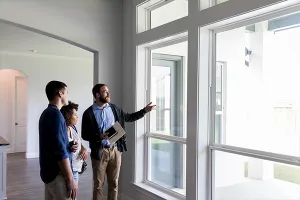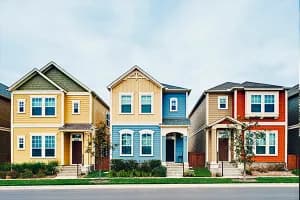
When designers and architects are asked about trends influencing them as the new year begins, fewer cite home offices as the primary focus. While homeowners still desire dedicated workspaces in the home, more are returning to outside offices full-time. Instead, new trends are emerging. Real estate agents can use this information to inform their clients, plan their business and keep the lines of communication open with clients who might not need to buy or sell, but are ready for a refresh for their home.
Here are a dozen noteworthy ones:
1. TV-Less Living Rooms
Once the focal point of many living rooms—taking center stage from fireplaces—the TV is on its way out, says designer and architect TC Chou of Design Determination in New York City.
Why now: More people are watching movies on personal devices and prefer arranging living rooms for multiple conversations rather than positioning one seating group toward a TV. The new look is “loungey,” with swivel chairs that pivot to face various groupings. For those who still want a TV, the emerging gaming room is an alternative. Others may opt for TV models with frames that change colors to blend with wall decor.
2. Authentic Homes With Character
Newer homes that promised low maintenance and ample amenities drove a boom in oversized modern farmhouses featuring white siding and black detailing. However, the enormous square footage often left little yard space, says Claire O’Connor of O’Connor Estates in Los Angeles.

Why now: In some markets, there’s a renewed interest in smaller homes that reflect classic styles like mid-century modern and Spanish Mediterranean. Smaller footprints allow for more land, while individuality and original materials add character. Even in kitchens, buyers are blending original elements with new appliances and cabinets that suggest a timeless era. “This way, the house has more character and doesn’t look mass produced,” she says.
3. Exterior Transformations With Virtual Tools
Dzinly, a site specializing in virtual exterior renderings, offers an interactive platform for homeowners to envision changes to their home’s facade with a few clicks. Human design craftsmanship and the power of artificial intelligence take exterior design to the next level.
Why now: Curb appeal is critical, but buyers may not like something about a home’s exterior and need to visualize the possibilities. “Homeowners can toggle between paint colors, design options, and updated landscaping through MLS listings and open houses, turning mediocre listings into showstoppers,” says Jackie Mosher, COO of Dzinly, outside Detroit.

4. More Glazing for Health and Light
Nature is showing up in more homes, offering both visual appeal and health benefits.
Why now: Increased evidence pinpoints nature’s positive effects, leading to larger, custom-designed windows, doors and skylights, according to Andersen Windows and Doors’ 2025 report. Changes include:
- “Multi-glide” doors can stack to create walls of light.
- Triple-pane glass meets energy-code requirements.
- Dark colors reduce heat absorption.
- Accessibility-friendly designs benefit those who use wheelchairs and walkers.
Architect Alexander Zilberman, AIA, of AZA Design in New York City is using more oversized windows and doors with triple panes and other coatings to cut energy costs. HIs firm works with AI to study site lines, views and light to provide the best views.
5. Cozy English-Style Kitchens
The all-white, sleek kitchen may have some competition thanks to a rise in the popularity of the cozy, English-style kitchens, reports Houzz.
Why now: After years of stark minimalism, coziness appeals to homeowners. They're making it possible with:
- Dark wood cabinetry
- Historic paint colors
- Natural countertops
- Ceiling beams and range alcoves
6. Designs for Easier Living
Convenience and low maintenance trends continue among homeowners and apartment dwellers.

Why now: People across all income levels want more time for other activities, says Alan McMahon, senior development manager of The Beach Company in Charleston, S.C. Trending are appliances and features that make tasks like cleaning and shopping easier. Examples include:
- High-end appliances with stainless fronts
- Low-maintenance backsplashes and countertops
- Cabinets that extend taller for fewer grocery trips
- Energy-efficient LED lighting
At the Jasper, a multifamily development by The Beach Company, enclosed parking garages with electric vehicle charging stations add even greater convenience.
7. Moving Beyond Major Metros
During COVID-19, homeowners largely stayed put—except those in dense urban areas. Now, smaller metro areas surrounding major cities are growing, according to a report produced by Chris Porter and Mikaela Arroyo of John Burns Research and Consulting, headquartered in Irvine, Calif.
Why now: Housing affordability is a key driver. To help lower prices, homes are getting smaller. According to the Federal Reserve Bank of New York, data from the last several months shows a growing share of households have said they expect to move. One reason is the pent-up demand for move-up homes after years of high mortgage rates and slow home sales.
8. New Building Methods: Mass Timber and Prefab
Stick-built and prefabricated homes remain dominant, but mass timber construction in conjunction with prefab methods is making inroads for single- and multifamily buildings.

Why now: Mass timber—using pine, spruce or Douglas fir—is more sustainable and visually appealing than steel. This method speeds on-site construction as the skeleton is built off-site using prefab engineering, key in areas prone to delays due to climate challenges. Architect Zilberman uses AI to streamline research on code requirements and building parameters.
9. Affordable + Market-Rate Housing Blends
Affordable housing remains a challenge, but combining market-rate and affordable units is becoming a viable solution.
Why now: Municipalities are more willing to offer tax credits and incentives for mixed projects. Cruz Companies has successfully implemented this model at Crestview in New Bedford, Mass., and Harvard Commons in Dorchester, Mass., says CEO John B. Cruz III. Combining unit types promotes diversity and equity while maintaining quality living features. It’s also more likely to be approved.
10. Solar and Battery-Ready Homes
With climate change causing more and stronger natural disasters, homeowners are taking control of their energy needs through solar power and battery-backup systems so they don't have to rely on the power grid.

Why now: “Batteries are becoming extremely popular as families look to protect themselves from outages,” says Ashley Yehuda, senior sales director at Sunrun, a clean energy company based in San Francisco. Sunrun reports that 60% of customers now pair solar with a battery, compared to 12% just a few years ago.
Incentives and rebates still exist in some states, and sleeker systems are available for lease or purchase. In California, solar photovoltaic systems are already mandated for new single-family and smaller multifamily homes.
11. Indoor Sports and Play Spaces
After prioritizing work-from-home setups, families are now focusing on recreation, and unwinding takes a larger role in home design.
Why now: Indoor golf simulators are gaining popularity and can double for soccer, baseball or dodgeball. These systems provide a shorter and more flexible alternative to a full round on the greens, appealing to both solo players and groups.
12. Design Packages for Simplicity
For some homeowners, choosing home finishes can be overwhelming due to the sheer number of options. Some builders recognize this and now offer design packages to simplify the process, says Christopher Brown, president of custom home builder Next Crafted in Roseville, Calif.
Why now: Life is busier than ever, and this approach removes the angst that a homeowner might feel when having to make multiple decisions on a new home that's essentially a blank slate. With packages, buyers can select from pre-paired options featuring trends like:
- Lighter wood tones such as white oak cabinets
- Natural stones
- Jewel-toned electric appliances
This approach removes decision fatigue while maintaining style and appeal.
By staying informed on these trends, homeowners can make thoughtful, future-ready decisions that align with their personal style and evolving needs.









